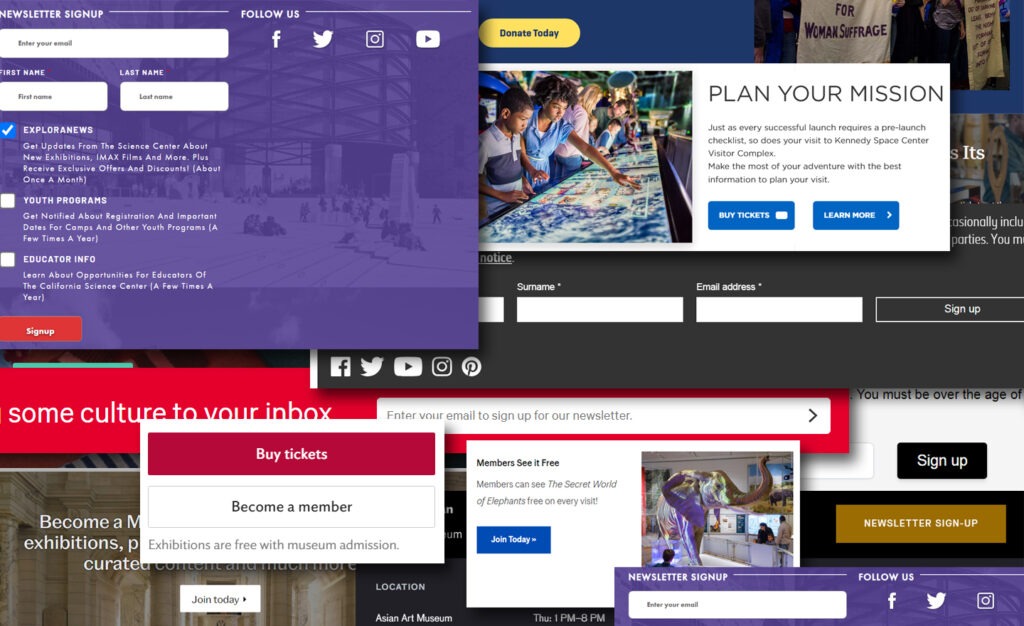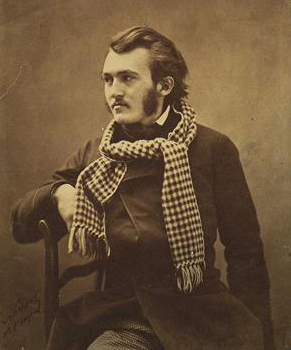Today, everyone has purchased a membership to something. Online subscriptions to Netflix or Spotify, access to a local gym or golf club, that special ID card that serves as an admission ticket to Costco—the appeal of membership is easy to see because of the clear and widely-appealing benefits each of these offer to those who purchase them.
Museum membership? For the average person, the benefits of museum membership—if one even knows it exists in the first place—is more mysterious. Why purchase a membership if admission is free or has already been paid for by a ticket? Is purchasing a membership primarily an act of charity, comparable to making a donation? Or is it primarily a means of gaining special privileges? What ultimate value does a membership offer? And how can museums do an effective job helping visitors understand the answers to these questions?
The good news is that a museum’s website offers an ideal space to alert visitors to the benefits of membership while driving home its purpose. By placing information about membership in strategic places on their websites, museums can effectively inform and remind visitors that purchasing a museum membership is mutually beneficial for both the visitor and the museum.
In this article, we will explore some of the ways museum websites are doing this well. But first, we should take a moment to re-evaluate some of the purposes that museum membership exists in the first place.
Thinking Through the Purpose and Appeal of Membership
Memberships are good for museums in many respects, but not all museums have thoroughly explored strategies for how and why they promote it. An article at museumprogress.com encourages museum leaders to carefully consider three big questions:
- Why do your members join?
- How does a member’s “why” for joining affect their behavior?
- What kind of member do you want to attract?
We should keep in mind that the answers to questions one and two may vary from member to member. Different ages groups may find membership appealing for different reasons, as has been shown in studies of younger and older Americans. At the same time, surveys reveal general trends about what museum members tend to value most and least in their membership benefits. For example, free/discounted entry to special events is at the top of the list; but the special and pricy magazine you send them? They’re actually not into that. (See here and here for more survey results.)
Another helpful distinction is to understand the difference between transaction-motivated members and mission-motivated members:
Transaction-motivated members are primarily motivated to join for benefits such as free admission and discounts, while mission-motivated members purchase memberships primarily for reasons related to the organization’s mission…these are the folks who say that their primary motivations for becoming a member are to “support the organization,” “support the organization’s mission,” “mission impact,” or “belong to the organization.” They also list affinity-based motivating factors ahead of more transactional motivating benefits. (“Mission-Motivated Members Find Greater Value in Their Memberships”)
To be sure, this distinction is more about identifying two ends of a spectrum than labeling two separate categories. All members are happy to help a good cause, and all members are happy to receive the benefits of membership. But when it comes to promoting membership on a website, as we will see below, a decision usually has to be made about to which motivation the museum will primarily appeal and how.
Overall, the better a museum understands its goals for membership, as well as the desires and intentions of its members, the most strategically it can think through how to best use its website for promoting membership.
Next, we will turn to some good examples of how museums are promoting membership on their websites. First, we will see how museums appeal to (potential) mission-motivated members and transaction-motivated members, as well as a third category—those who purchase gift memberships for friends and family. Then, we will look at some of the more technical aspects of how membership promotion can be incorporated into effective site design.
1) Appealing to Potential Mission-Motivated Members
One museum that strongly emphasizes its mission in appealing to new potential members is the National Baseball Hall of Fame. By joining, one can “Be a part of something greater” by “Preserving History,” “Honoring Excellence,” and “Connecting Generations.” The membership page highlights its mission this way:
…through the Hall of Fame’s Membership Program, baseball fans from around the country and around the world can be part of the team that is preserving the Game’s history and celebrating the all-time greats.
In addition to being part of preserving baseball history, Members receive a full roster [of] benefits.
But for many, the benefits of Membership cannot be held in their hands. Their Membership brings with it the knowledge that they are part of baseball’s history.
Members are proud to help ensure that fans everywhere have a home to celebrate the history of baseball and preserve it for generations to come. Every Member is preserving history, honoring excellence and connecting generations.
The site’s homepage features a link to the membership page using similar language (see image below). For those not yet persuaded to simply support its mission, a neighboring link informs visitors that members can receive free shipping and 10% discounts on all merchandise.

Many other museums use similar mission-driven language to appeal to potential members:
“The membership program supports our mission and helps sustain this sacred site of remembrance and reflection.” (9/11 Memorial and Museum)
“Take a moment to reflect on your personal connection to World War II. Maybe your father or grandfather served in the Pacific or fought across the plains of Europe. Or perhaps your mother or grandmother supported the war effort by powering the “arsenal of democracy” here at home. Whatever their involvement, it deserves permanent recognition on the Honor Roll at America’s national WWII Museum. Become a member today and ensure that your family’s legacy is never forgotten.” (National WWII Museum)
“Your support helps us further scientific research and exploration.” (Field Museum)
“The Brooklyn Museum is one of the world’s most welcoming and contemporary encyclopedic museums and is every bit Brooklyn: creative, relevant, diverse, and trailblazing. When you join as a Member, you celebrate the great art, big ideas, and courageous conversations that can only be found here.” (Brooklyn Museum)
“Members are part of something incredible. Your support helps us are for and grow our national collection, share the benefits of creativity, and champion the right to art for everyone” (Tate)
Similar language might be found on a typical donation page, laying out the good work an institution is doing. But promoting membership instead of a simple donation provides two additional benefits. First, a member (as opposed to a simple donor) gets to feel a greater connection to the organization of which he or she is now a part. As the Art Institute of Chicago highlights on their homepage, becoming a member is synonymous with becoming part of a community:

And second, membership offers tangible benefits, many of which range from being somewhat important for mission-motivated members to crucial for transaction-motivated members.
2) Appealing to Potential Transaction-Motivated Members
If the National Baseball Hall of Fame’s messaging sits on one side of the mission-motivated vs. transaction-motivated spectrum, the messaging on the website of the Minneapolis Institute of Art sits on the other. Their membership page announces:
Membership is all about you—your benefits, your activities, your interests. Use the benefits that work for you!
Many sites use transaction-motivated language on their homepage to encourage visitors to click to see the benefits of membership:

American Museum of Natural History


Ultimately, the question is not whether to appeal to potential mission-motived members or to potential transaction-motivated members, but how to appeal to both groups, understanding that there will be a strong overlap. Many websites emphasize both at once. As the Whitney Museum succinctly puts it:
Members play a crucial role in helping care for the Whitney. In appreciation, Members enjoy these benefits…
The California Science Center emphasizes both this way:
Join us in our mission to stimulate curiosity and inspire science learning in everyone by creating fun, memorable experiences, because we value science as an indispensable tool for understanding our world, accessibility and inclusiveness, and enriching people’s lives. (Give & Join)
As a Member of the California Science Center Foundation, you will support a dynamic educational resource for you, your family and the community. In appreciation for your generous support, Members enjoy a year of exciting benefits and Members-only experiences. (Membership)
And the Guggenheim features this image and blurb on their homepage:

3) Appealing to Gift-Givers
Finally, museum memberships make appealing gifts for friends and family. In November and December, it is common to see homepages promoting membership as a great gift idea. Here’s a few examples:

American Museum of Natural History

Houston Museum of Natural Science




Children’s Museum of Indianapolis
The North Carolina Museum of Art highlights the way gift memberships serve multiple purposes by benefiting the museum, the recipient, and even the giver:
Gifting a Museum membership is truly the gift that gives back. It is a great way to support the NCMA while also sharing your love of art with someone who matters to you. Membership gifts make a clear statement about what you feel is important—creating community through cultural experiences. Share the NCMA with those meaningful to you, and tell them why “membership matters.” (NCMA- Members)
In sum, recognizing the three primarily motives for purchasing memberships— (1) to support the museum’s mission, (2) as a transaction to gain benefits, and (3) for gift-giving—and seeing how they overlap can help museums strategize about how to most effectively market museum memberships.
Next, we turn to optimal ways to incorporate membership promotion into a museum’s website design.
Design Strategies
Homepage & Menu
For visitors coming to the website already intending to purchase a membership, a clear link on the homepage is obviously needed. Locating a “Membership” or “Become a Member” link at the top of the page or as a sub-link under a main link like “Support” makes the page easy to find.
Some sites highlight membership with additional methods. The American Museum of Natural History features a pop-up at the top of the homepage advertising membership (when closed, it does not come up again on the same visit):

The Tate features a special button in the top right of the page:

Further down the homepage, many museums highlight the value of membership and feature links to the membership page:



Membership and Ticket Sales
When membership offers free or reduced prices for ticket sales, notifying and reminding visitors about membership benefits in the context of ticket purchases is an ideal method of promoting membership. (I speak from firsthand experience, having purchased a museum membership in this manner before!) This may take the form of a simple link, or a longer explanation:




Houston Museum of Natural Science
Visualizing Benefits
Finally, displaying membership benefits in an easy to understand and attractive way—especially when there are many levels of membership with different options that might require a lot of text—helps purchasing membership an easier and more appealing experience. Here are some examples:





National Baseball Hall of Fame
Other methods of organizing membership options include the use of tabs, a horizontal scrolling gallery, and toggle menus.
Is Your Website Attracting New Museum Members?
Whether it is time to initially implement an online membership strategy or to re-evaluate an old one, having surveyed the examples we have considered in this article, a next step is to think through the following questions:
- How can we use our website to offer potential members the opportunity to support our mission in a way visitors find fulfilling and meaningful?
- How can we use our website to offer potential members the kinds of personal benefits that they feel are worth the price of membership?
- How can we use our website to encourage the purchase of gift memberships?
- How are our homepage, links menu, and ticket pages designed in such a way that users are reminded and encouraged to consider purchasing membership?
- How are the benefits of membership organized in a way that is visually appealing and easy to navigate?
As we noted at the beginning, countless people are already members of gyms, Costco, and Spotify. With the right strategies and a well-designed website, museums can encourage more and more people to add one more to that list: museum member.










